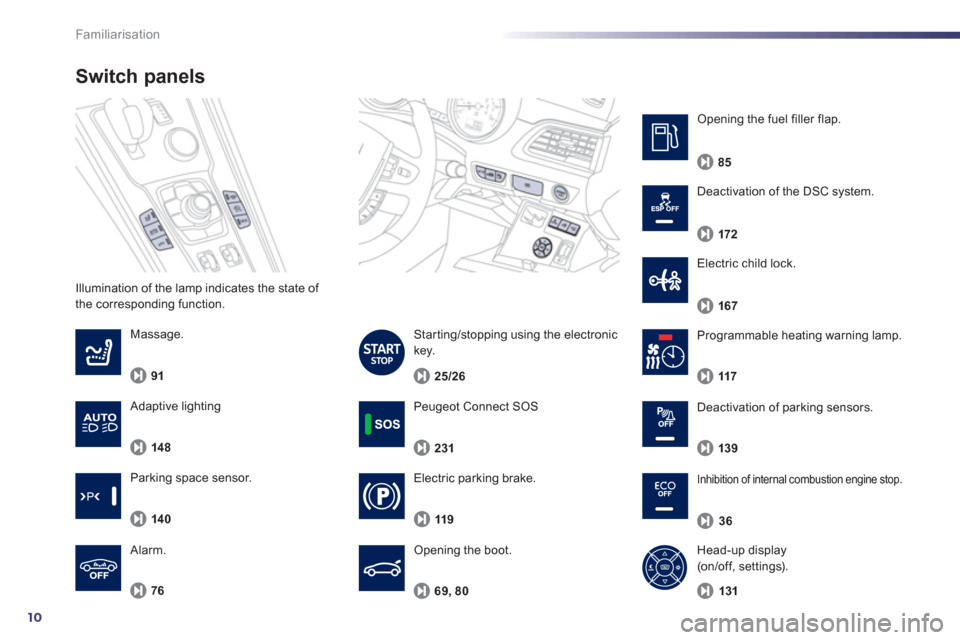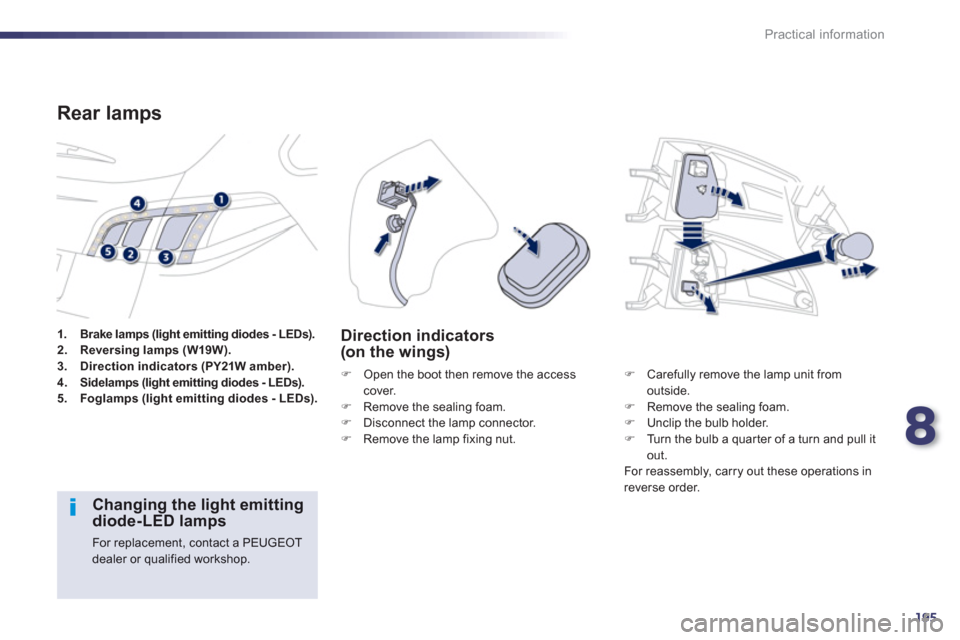2012 Peugeot 508 RXH brake light
[x] Cancel search: brake lightPage 4 of 304

.
.
Contents
Instrument panel 45
Indicator and warning lamps 46
Gauges and indicators 57
Tr ip computer 62
Setting the date and time 65
Instruments and controlsFamiliarisation
Remote control key 66
Alarm 76
Electric windows 78
Boot 80
Motorised tailgate 81
Panoramic sunroof 84
Fuel tank 85
Diesel misfuel prevention 86
Access
Front seats 88
Rear seats 92
Mirrors 94
Steering wheel adjustment 96
Interior fi ttings 97
Boot fi ttings 100
Heating and Ventilation 106
Dual-zone digital air conditioning 108
Quad-zone digital air conditioning 111
Rear screen demist - defrost 116
Programmable Heating / Ventilation 117
Comfort
Electric parking brake 119
6-speed electronic gearbox 126
Hill star t assist 130
Head-up display 131
Speed limiter 134
Cruise control 136
Parking sensors 138
Parking space sensors 140
Driving
Lighting controls 142
LED lamps 145
Automatic illumination of headlamps 147
Headlamp adjustment 150
Directional lighting 151
Wiper controls 152
Automatic rain sensitive wipers 154
Cour tesy lamps 156
Interior mood lighting 157
Visibility Hybrid system
Presentation 22
Starting / switching off 25
Ready lamp 29
HYbrid4 mode selector 29
Energy consumption / generation indicator 32
Display of hybrid power fl ow 33
Eco off 36
Eco-driving 37
Consumption 39
High voltage battery 40
Vehicle recovery 44
Page 12 of 304

10
Familiarisation
Illumination of the lamp indicates the state of
the corresponding function.
Switch panels
Electric parking brake.
Opening the boot.
119
Massage.
91
76
Al
arm.
El
ectric child lock.
69
, 80
167
Peu
geot Connect SOS
231
Starting/stopping using the electronic
key.
25/26
Deactivation of parking sensors.
139
Inhibition of internal combustion engine stop.
36
Programmable heating warning lamp.
117
Parkin
g space sensor.
140
Deactivation o
f the DSC system.
172
Opening the fuel filler flap.
85
Adaptive lighting
148
Head-up displa
y (on/off, settings).
13
1
Page 14 of 304

12
Familiarisation
11.Front door window demisting/defrostingvent.
12.Windscreen demisting/defrosting vent.
13
. Steering lock and star ting with the key. 14 .
Starting using the electronic key.
15. Audio equipment steering wheel controls.
16.Wiper / screenwash / trip computer stalk.
17. Central locking and hazard warningbuttons.
18. Screen.
19.Central adjustable air vents.
20.Passenger's airbag. 21. Side adjustable air vents.
Instruments and controls
1.
Cruise control / speed limiter controls. 2.
Headlamp height adjustment. 3.
Lighting and direction indicator stalk
4.
Instrument panel. 5.
Driver's airbag.Horn.
6.Gear selector.
7. HYbrid4 mode selector. 8.12 V accessory socket
USB por t / auxiliary socket. 9. Bonnet release lever.10.Fusebox.
22.
Glove box / Passenger's airbag deactivation. 23.
Electric parking brake.
24.
Central armrest with storage. 25.Storage (according to version).26.Audio system. 27.
Heating / air conditioning controls.28.
Alarm / Peugeot Connect SOS -
Peugeot Connect Assistance.29. Peugeot Connect Navigation (RT6)controls. 30.
Massage / Adaptive lighting / Parkingspace sensor.
Page 39 of 304

.
37
Hybrid system
Eco-driving
Eco-driving is a range of everyday practices that allow the motorist to optimise their fuel consumption and CO2 emissions.
Optimise the use of your
gearbox
Use automated mode Aas much as possible as this optimises gear changes to suit the
circumstances.
Drive smoothly
Maintain a safe distance between vehicles, use engine braking rather than the brake pedal, and press the accelerator progressively. These practices contribute towards a reduction in fuel consumption and CO2 emissions and also helps reduce thebackground traffic noise.
If your vehicle has cruise control, make use of the system at speeds above 25 mph (40 km/h) when the traffic is flowing well.
Control the use of your
electrical equipment
Before moving off, if the passenger compartment is too warm, ventilate it byopening the windows and air vents before using the air conditioning.
Above 30 mph (50 km/h), close the windowsand leave the air vents open. Remember to make use of equipment that canhelp keep the temperature in the passenger compartment down (sun roof and window blinds...).Switch off the air conditioning, unless it has automatic digital regulation, as soon as the desired temperature is attained.Switch off the demisting and defrosting controls, if not automatic.
Switch off the heated seat as soon as possible.
Switch off the headlamps and front foglampswhen the level of light does not require their use.
Avoid running the Diesel engine when stationary, par ticularly in winter; your vehiclewill warm up much faster while driving.
As a passenger, if you avoid connecting your multimedia devices (film, music, video game...), you will contribute towards limitingthe consumption of electrical energy, and soof fuel.
Disconnect your por table devices beforeleaving the vehicle.
Page 48 of 304

46
Instruments and controls
Indicator and warning
lamps
Visual indicators informing the driver that a system is in operation, switched off or has a
fault.
When the ignition is switched on
Certain warning lamps come on for a few seconds in the instrument panel and/or
instrument panel screen when the vehicle's
ignition is switched on.
When the engine is started, these same
warning lamps should go off.
If they remain on, before moving off, refer to the
information on the warning lamp concerned.
Associated warnings
The switching on of cer tain warning lamps maybe accompanied by an audible signal and a message in the instrument panel screen.
The warning lamps may come on continuously(fixed) or flash.
Certain warning lamps may come on inone of two modes. Only by relating thetype of lighting to the operating status
of the vehicle can it be ascertainedwhether the situation is normal or whether a fault has occurred.
1
2
2
2
3
3
3
2
3
3
With the vehicle stationar y
, use the left handythumb wheel to move through the menus, so as to configure the vehicle settings (driving andcomfort systems, ...).
- Rotation (other than menu): scroll through
the list of active functions available,
- Press: main menu, confirm the selection,
- Rotation (in a menu): move up or down in
the menu.
Main menu
Vehicle parameters Screen settin
gs
Preheatin
g / Preventilation
Driving position setting
Unlocking boot only
Driving assistance
Speeds memorised
Rear wipe in reverse
gear
Automatic parkin
g brake
Lighting
Welcome lighting
Guide-me-home headlamps
Directional headlamps
Parameters
Language
Units
Fuel consumption
Te m p e r a t u r e
Colours
3
1
2
2
3
2
3
1
2
Page 124 of 304

122
Driving
Emergency braking
In the event of a failure of the main servicebrake, a continuous pull on the control lever Awill stop the vehicle.
The dynamic stability control provides stability
during emergency braking.
If the emergency braking malfunctions, a message will be displayed.
I
f a failure of the DSC system is
signalled by the lighting of this
warning lamp, then braking stability is
not
guaranteed.
In this event, stability must be assured by the
driver by repeating alternate "pull-release" actions on the control lever A.
Emergency parking brake release
�)if your vehicle has one, take out the vehicle chock B , located behind the rear seats.�)On a slope, immobilise the vehicle byplacing a chock in front or behind one of
the front wheels, opposing the slope. On level ground, immobilise the vehicle byplacing a chock in front or behind one of
the front wheels.
In the event o
f fault with the electric parkingbrake or a battery failure, an emergencymechanical control can be used to manually
releasethe parking brake.�) Immobilise the vehicle (or chock it if the
brake pedal has not been released), with
the hybrid system active, place the gear selector in position M or R.�)
Switch of the hybrid system, but leave the
ignition on. If you are unable to immobilise
the vehicle, do not operate this control and contact a PEUGEOT dealer or a qualified
workshop as soon as possible.
The emergency braking must only be used in exceptional circumstances.
Page 173 of 304

7
171
Safety
Snow driving assistance
(Intelligent Traction Control)
Your vehicle has a system to help driving on snow: Intelligent Traction Control. This automatic system continuously checks for situations of difficult surface adhesion thatcould make it difficult to move off or makeprogress on deep fresh snow or compacted snow.
In these situations, Intelligent Traction
Controllimits the amount of wheel slip to provide the best traction and trajectory control.
In extremely severe conditions (deep snow,mud…), it can be useful to temporarilydeactivate the dynamic stability control andwheel anti-slip
systems to allow a degree of
wheel spin and so recover grip.
It is recommended that the system be
reactivated as soon as possible.
Snow t
yres are strongly recommended on sur faces offering low levels of adhesion.
Operation
Anti-lock braking system (ABS)and electronic brake force
distribution (EBFD)
In emergency braking, press very firmly without releasing the pressure.
When changing wheels (tyres and rims),make sure that these are approved for your vehicle.
Normal operation of the ABS may makeitself felt by slight vibrations of the brake pedal. When this warnin
g lamp comes on,
accompanied by an audible signal
and a message, it indicates that
there is a fault with the ABS, which could cause loss of control of the vehicle whenbraking.
When this warnin
g lamp comes on,coupled with the STOPwarning lamp,
accompanied by an audible signaland a message, it indicates that
there is a fault with the electronic brake forcedistribution (EBFD), which could cause loss of control of the vehicle when braking.
You must stop as soon as it is safe to do so.In both cases, contact a PEUGEOT dealer or a qualified workshop.
Page 197 of 304

8
195
Practical information
1.Brake lamps (light emitting diodes - LEDs).2.Reversing lamps (W19W).3. Direction indicators (PY21W amber).4.Sidelamps (light emitting diodes - LEDs).5.Foglamps (light emitting diodes - LEDs).
Rear lamps
Direction indicators(on the wings)
�)
Open the boot then remove the accesscover.�)
Remove the sealing foam.�)
Disconnect the lamp connector. �)
Remove the lamp fixing nut.
�)
Carefully remove the lamp unit from outside.�)
Remove the sealing foam. �)
Unclip the bulb holder. �)
Turn the bulb a quar ter of a turn and pull itout.
For reassembly, carry out these operations in
reverse order.
Changing the light emitting diode-LED lamps
For replacement, contact a PEUGEOT dealer or qualified workshop.